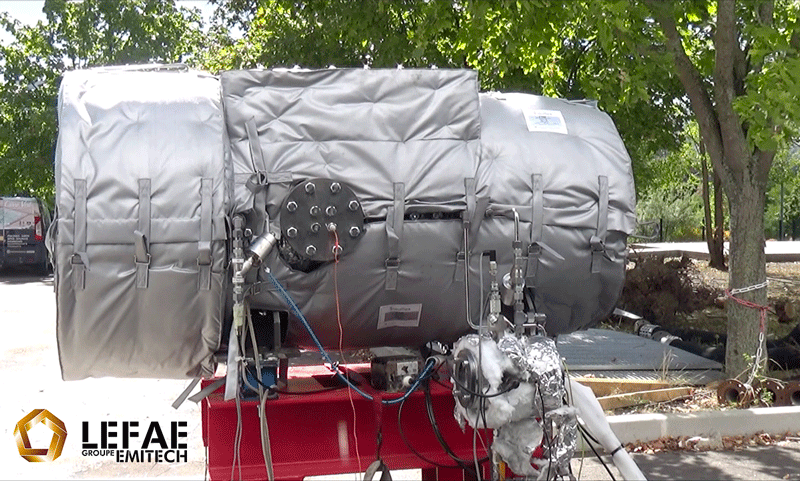Tests in explosive atmosphere (RTCA DO 160 section 9, MIL STD 810 Method 511.5, MIL STD 202-109, EUROCAE-ED-14D)
This type of test is intended to verify the conformity of equipment installed in areas where there is a risk of explosion in the presence of fluids and hydrocarbon vapors (equivalent to the ATEX principles). These explosive conditions are present in aeronautical activities but also industrial, automotive and marine activities.
Resistance to explosion - These tests subject the equipment under test to a vacuum environment with a gaseous mixture of fuels. The device must operate and be subjected to the activations available to it (turning buttons, pressing switches) and must not ignite the environment.
Our tests are performed in accordance with the requirements of EUROCAE-ED-14D, RTCA DO-160, MIL-STD-810, MIL STD 202-109. These standards allow to evaluate:
- The functioning of the tested equipments in an explosive atmosphere without triggering the explosion of the stoichiometric mixture Air/Fuel
- The capacity of the protective envelopes (ATEX principle) of the tested equipment to contain an explosion or a flame during the activation of these materials. The characterization of the containment will be demonstrated by the preliminary insertion and the triggering of the explosive mixture in the envelope.
- The temperature rises in circuits or components (e.g. hydraulic or exhaust systems, intermittent or permanent hot spots) that may cause the mixture to explode.

Our test bench is an internal realization and has been designed to allow the installation and the implementation of the explosion conditions defined below:
- Volume of the chamber is 450 dm3
- Absolute pressure conditions up to 12 200 meters (40 000 pieds)
- Temperature up to 120 °C (248 °F)
Sealed passages are available on the walls of the test chamber to allow activation or supply of the tested equipment (e.g. electrical control, fluid supply, mechanical activation).
Our bench can be used to explore the behavior of intrinsically explosive products and analyze the toxic gases resulting from their explosion.
Example of the RTCA DO 160 Section 9.0 - Explosive atmosphere testing
The RTCA DO 160 standard on testing in explosive atmospheres defines the requirements for aircraft equipment that may come into contact with flammable substances.
The DO-160G test standard also refers to normal and fault conditions that may occur could be subjected to flammable materials during flight operations.
The flammable test fluids, vapors and gasses simulate those used in conventional aircraft that require oxygen for combustion.
This test is implemented to demonstrate the ability of the equipment to operate in a flammable environment without causing an explosion, or to show that the design is capable of preventing the explosion from propagating outside the equipment enclosure.
There are three types of test specified in the RTCA/DO-160. These tests are containment test, non-ignition test and components or surface temperature test.
Explosion-Proof Testing Equipment Zones RTC DO 160
The RTCA DO-160G test standard states that equipment should be installed in aircraft zones. These zones depend on their ability to prevent vapor explosion during their normal functioning.
An atmosphere in a space in which uncovered flammable fluids or vapors exist or may exist, either continuously or intermittently (for example, in fuel tanks or fuel systems)
Equipment installed in such an environment must not be capable of igniting the surrounding atmosphere under its normal or double failure operating conditions
An atmosphere in which flammable mixtures can be expected to occur only as a result of a (single) spillage or leakage caused by a defect.
Equipment installed in such environments must not be capable of igniting the surrounding atmosphere in their normal operating modes or in the event of a possible failure. Only a single failure of the equipment should be considered.
Atmosphere in which flammable mixtures can be expected to occur. These can be the result of a single spillage or a single leakage causing a failure. Equipment installed in such an environment should not be capable of igniting the surrounding atmosphere in its normal operating modes.
An atmosphere within a designated fire zone or an area in which flammable mixtures cannot be expected to occur as a result of a double spillage or leakage causing a failure. No requirements apply to equipment located in this area.
Explosive Atmosphere Test Equipment Categories of the RTCA DO 160
The DO-160G test standard specifies three primary categories of equipment.
During normal operation, the temperature of any surface of this equipment will not rise to a level that could cause ignition. In addition, no other operating parts will cause ignition so that it meets the non-ignition test.
The ignition of an explosive mixture is contained within the equipment without igniting the surrounding explosive atmosphere, so it passes the containment tests.
Hermetically sealed equipment are identified as Category A equipment.
This equipment is not hermetically sealed.
This equipment is also not contained in cases designed to prevent flame and explosion propagation.
This equipment is designed so that in operation the temperature of any internal or external surface will not rise to a level capable of causing ignition.
Also, no operating internal part will cause ignition so that it meets the non ignition test.
This equipment is not intended for installation in environment I.
This equipment contains hot spot surfaces (external or internal) and are non-spark producing under normal operating conditions.
These equipment are designed so that in normal operation the temperature of any internal or external surfaces will not rise to a level capable of causing ignition.
Hermitically sealed equipment meeting temperature requirement on external surface shall be identified as Category H equipment.

